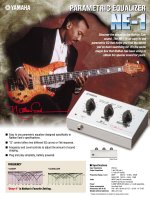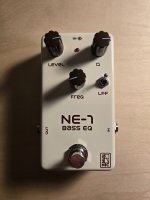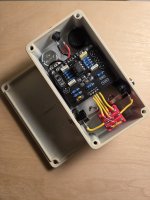You are using an out of date browser. It may not display this or other websites correctly.
You should upgrade or use an alternative browser.
You should upgrade or use an alternative browser.
EQ Anyone?
- Thread starter Nic
- Start date
I was not sure how I would mount the board at first and those were kind of tall. They fit well around the pots.Hey, neat build!
Your electro caps soldered to the rear, just an aesthetic choice? It looks super tidy.
BuddytheReow
Breadboard Baker
Nice, clean build! Can you compare this to a Mercurial Boost? Better? Worse? Same?
Aleph Null
Well-known member
Looks classy! Are the electros on the underside?
Sadly I'm of no help here, I never tried the mercurial.Nice, clean build! Can you compare this to a Mercurial Boost? Better? Worse? Same?
Yep, they are under because of space managementLooks classy! Are the electros on the underside?
YourGuitarist
Member
Reminds me of @Passinwind preamp.
Never thought about that, but I get what you are saying.Reminds me of @Passinwind preamp.
Alan W
Well-known member
I wasn't familiar with the NE-1, so I just did a bit of research to confirm my guess. Short answer—no, they do different things (although the Mercurial might be able to closely imitate what the NE-1 does. Mercurial is a boost, with a tunable notch filter. You pick a center frequency, and then you can boost it, or reduce it, and then it gets blended with the original signal and both get output through a gain stage that can also allow it to be a boost. (One of my most favorite sounding IC based boosts.)Nice, clean build! Can you compare this to a Mercurial Boost? Better? Worse? Same?
The NE-1 takes that center frequency you select, and then applies a notch filter to it, of tunable Q. I'm not sure if the level control is for output, or for how much of the effect is mixed with the original signal (I had assumed the former, but their description makes me think the latter. Plus @Nic saying that its cuts volume—which makes sense, since the filter is subtractive). I'm guessing the higher you turn the level the lower the output gets—does that track with your experience, @Nic?

EDIT: I looked more carefully at their charts, and hadn't noticed the dashed line before, so those graphs do imply that it can add gain also.
Last edited:
Alan W
Well-known member
It's funny, because of the design I figured it was based on a Boss pedal, and then saw that the NE-7 was the Boss 7 band. And I've been out of the pedal building hobby for a while (just taking a break!) I didn't realize that the post title was the PCB name—Boy, Robert has BEEN BUSY!
And. as several others have said, really nice clean work.
And. as several others have said, really nice clean work.
I will have to play with it a little more. I really think level work intuitively, so CW for higher output, it's just that unity is really high, I'll really have to confirm the interaction between the knobs and switch.I'm guessing the higher you turn the level the lower the output gets—does that track with your experience, @Nic?
Passinwind
Well-known member
I actually have a different EQ pedal in design that combines a one band PEQ and a variable HPF, using a 9V—> +/- 15V Traco power converter chip. It has plenty of headroom to drive any power amp directly and my primary projected use case is FRFR powered speakers. I hope to add it to my open source GitHub repository sooner than later.Reminds me of @Passinwind preamp.
YourGuitarist
Member
You had a design where the resonant LPF was used like a tone control yeah. Kind of an alembic deal?I actually have a different EQ pedal in design that combines a one band PEQ and a variable HPF, using a 9V—> +/- 15V Traco power converter chip. It has plenty of headroom to drive any power amp directly and my primary projected use case is FRFR powered speakers. I hope to add it to my open source GitHub repository sooner than later.
That's what I was thinking of when I brought it up.
Passinwind
Well-known member
Yeah, that’s the current open source one.You had a design where the resonant LPF was used like a tone control yeah. Kind of an alembic deal?
That's what I was thinking of when I brought it up.



